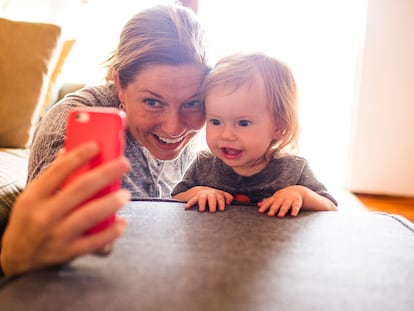‘A 12-year-old is not ready’: Why thousands of parents are teaming up to delay their children’s first cell phone use
A WhatsApp chat group based in Barcelona, Spain, filled up in just a few weeks with families who want to restrict devices among schoolchildren. It is the largest example of a movement that is growing among parents across Spain

“While [our] children are playing in the park, we talk about everything,” says Elisabet Garcia Permanyer, a mother of three children aged 7, 9 and 10. “One issue of concern is screens and having normalized that the child will have a cell phone when s/he reaches the 1st ESO [Spanish secondary education; 12 years old],” she adds. At the end of September, Garcia Permanyer created a WhatsApp group because “the news that I am seeing is frightening: addiction problems, mental health, anorexia, suicide.” She wanted to share the news with other parents.
She gave the chat group a name with her neighborhood and a slogan: “Poblenou_adolescència lliure de mòbil [”Poblenou_cell-phone-free adolescence”]. Barely a month later, the group has exploded in popularity, reaching the WhatsApp limit of 1,024 participants. They are not only from her neighborhood; there are members from all over Barcelona. There are two overlapping objectives behind this movement: to remove cell phones from the neighborhood schools and to ensure that more families do not automatically buy a cell phone with internet on it for their children as soon as they turn 12 and start high school.
This Wednesday, the group organized its first face-to-face meeting. There were about 30 people and “we set up a roadmap with proposals and working committees,” says Xavier Casanovas, one of the parents in attendance. They must also decide whether to expand the chats in each district of Barcelona.
A “great topic”
“I didn’t expect it… I didn’t cause anything, nor did I seek out contacts,” Garcia Permanyer says. “It has [snowballed] by itself. I just took the initiative to make a chat group for my circle. When I saw that it grew so exponentially, I realized that it was a great issue,” she adds. A week ago, the coordinator of the family associations from 15 schools in Barcelona’s neighborhood of Gràcia started a form for parents entitled “Minors and the use of cell phones and media.” On Wednesday, it had already received 901 responses. The organizers told EL PAÍS about the provisional result of a question they posed: “There are groups of families who propose that teenagers should not have smartphones until they are 16 years old, as recommended by the European Union. What do you think?” Over 70% agreed. Only 10% believed that 16 years old is “too late.”
Marta Hernández, a parent at a school in the same neighborhood, is behind that initiative. She saw that a similar form had worked in a charter school in Barcelona last year. “There, 99% said they didn’t want to give their children cell phones or that if they did it was because of social pressure. Now they are doing first [ESO] without a cell phone,” Hernandez says of that school. Her goal is to do the same in Gràcia and—why not?—in Barcelona. “The problem is access to social media. They are not mature enough. WhatsApp is for 16-year-olds. What are we doing giving WhatsApp to a 12-year-old? Even if they don’t use it at school, they continue cyberbullying at home. Let’s be conscious families and not give them a weapon that, if it were tobacco or alcohol, we would not give them. It is not regulated, and we give it [to kids] as if it were nothing. There will come a day when [cell phones] will not be given [to kids] because of the harm they cause. It’s not banning them; it’s not giving them [in the first place],” Hernandez says.
Apart from these two initiatives, there are other family associations that are trying to unite in other places. In addition to other neighborhoods in Barcelona such as Sarrià and Eixample, in Catalonia there are similar groups in Sant Cugat, Cardedeu, Sabadell and Girona. The debate has spread to parents’ chat groups all over Spain. “We started with a WhatsApp group at school,” says Jaume Bombardó of Sant Cugat. “Then we went further, at the local level. Everything came about spontaneously, and we have seen that there’s a general concern,” he adds.
Basque trailblazers
All these Catalan cases emerged in 2023. But the movement’s pioneers are in Gipuzkoa. In the city of Tolosa, which has a population of 20,000, parents have been organizing for two years to “reflect on the use of screens, not only cell phones, and to try to delay the age when cell phones are used,” says Orkatz Goenaga, one of the organizers. And they are not the first to do so: they were preceded in Zarautz and Usurbil, and the media impact has led to more groups in Bizkaia. Have they been successful in these two years? “We haven’t quantified the results, but we do see that before, no one in the first year of ESO reached Christmas without a cell phone, and now they finish the first year and there are still children without a cell phone. It’s no longer [unusual],” says Goenaga.
In the Basque Country, this concern was born of fears about mental health and learning problems. The origin of the movement’s second wave in Catalonia stems from “the news” and particularly group chats that serve to share worrying information. “All of a sudden, there has been a series of news stories that have caused some scandal,” Xavier Casanovas says, offering possible reasons for this movement’s spread. “In addition, social media presence is increasing. There is the post-pandemic effect [where] the use of digital tools came on strongly and now that we are leaving [that period behind] and returning to a certain normality there is some rejection. And then there is more scientific evidence of the harm that screens do at certain ages, adolescents’ addictions to cell phones and social media, the social pressure of images,” he adds.
The name of Francisco Villar, a clinical psychologist and expert on suicide, has come up in at least three conversations between EL PAÍS and parent organizers: “I contacted Francisco Villar, and he came to the school to give a talk. Over 40 people came. That’s when it all started,” says Marta Hernandez. She adds that about 10 families at the school have not given their 6th-grade children cell phones because of that talk. “It is extremist, but it makes us react. It’s very clear to me that there are other views, but there are many people who believe what he says,” she notes.
Villar published an article in this newspaper a week ago, arguing that cell phones should be banned until the age of 16. This psychologist has been interviewed dozens of times in the media, and this Tuesday he published a book entitled Cómo las pantallas devoran a nuestros hijos [How Screens Devour Our Children]. In calling for the ban, the main evidence Villar provides is that his hospital’s emergency room has “gone from attending 250 episodes of suicidal behavior (ideation, threats, gestures and attempts) in 2014 to 1,000 episodes in 2022.” What is the “hidden cause” of that increase? According to Villar, “screens remove their tools” for making the world a more livable place.
Is it that bad?
The advent of new technology as impactful as the internet, cell phones and social media is a challenge. There hasn’t been an adult generation raised with cell phones since childhood yet. “The little technology that I was taught when I was in school I don’t use today. Am I technologically illiterate? No. What you will be taught and what you will use later has nothing to do with it. On the other hand, there is a part of values, of ethics, of knowing how to be, that will accompany you for your entire life,” says Bombardó.
Is there evidence that cell phones pose a risk to young people? “Concerns about the impact of social media on mental health, the spread of cyberbullying, easy access to explicit content, uncontrolled chats and cases of adult abuse are backed up by research, real incidents and legal action,” says Leen d’Haenens, a professor at the University of Leuven in Belgium. Parents’ concern for their teenagers is understandable. How are they going to buy a device for their children that exposes them to serious potential risks, and which is very new technology that didn’t exist when they were little? Isn’t it better to delay this ticking time bomb? But it’s not clear that it is. Some studies focusing on the consequences of cell phone use in young people see more risks than benefits in simply delaying the age when they start using it. “When I see these things, I wonder why I’ve been doing research for 15 years,” says Gemma Martínez, a researcher at the European EUKids Online group at the University of the Basque Country.
“I’m worried about where this panic is coming from,” adds Martínez. She sees that this wave of parental activism is focused on risks rather than opportunities and fears that it will hurt Spanish children even more: “Spanish children’s level of digital skills leaves something to be desired compared to other European kids. You can’t convince your neighbor not to give their child a cell phone based on the discourse of fear, it’s very dangerous. It’s a step backwards, it discourages me,” she adds.
Full of nuances and complexity, Martínez’s discourse doesn’t mesh well with the clarity of those who call for banning cell phones until the age of 16. For her part, Martínez advocates introducing common devices in classrooms (but not personal ones), freeing parents from a responsibility that is not theirs alone. She insists that, from a young age, critical digital literacy is essential, and that hiding cell phones is not a solution. But perhaps restricting them is a simpler solution.
Sign up for our weekly newsletter to get more English-language news coverage from EL PAÍS USA Edition
Tu suscripción se está usando en otro dispositivo
¿Quieres añadir otro usuario a tu suscripción?
Si continúas leyendo en este dispositivo, no se podrá leer en el otro.
FlechaTu suscripción se está usando en otro dispositivo y solo puedes acceder a EL PAÍS desde un dispositivo a la vez.
Si quieres compartir tu cuenta, cambia tu suscripción a la modalidad Premium, así podrás añadir otro usuario. Cada uno accederá con su propia cuenta de email, lo que os permitirá personalizar vuestra experiencia en EL PAÍS.
¿Tienes una suscripción de empresa? Accede aquí para contratar más cuentas.
En el caso de no saber quién está usando tu cuenta, te recomendamos cambiar tu contraseña aquí.
Si decides continuar compartiendo tu cuenta, este mensaje se mostrará en tu dispositivo y en el de la otra persona que está usando tu cuenta de forma indefinida, afectando a tu experiencia de lectura. Puedes consultar aquí los términos y condiciones de la suscripción digital.
More information
Últimas noticias
David Bowie, the galactic thinker who encouraged us to break new ground
John Berger and the loss of rural culture
From police officer to bloodthirsty kidnapper: Terror in Mexico during the years of ‘The Ear Chopper’
Alain Aspect, Nobel laureate in physics: ‘Einstein was so smart that he would have had to recognize quantum entanglement’
Most viewed
- David King, chemist: ‘There are scientists studying how to cool the planet; nobody should stop these experiments from happening’
- Reinhard Genzel, Nobel laureate in physics: ‘One-minute videos will never give you the truth’
- Oona Chaplin: ‘I told James Cameron that I was living in a treehouse and starting a permaculture project with a friend’
- Sinaloa Cartel war is taking its toll on Los Chapitos
- Mexico completes its trade shift with the entry into force of tariffs on China and countries without trade agreements











































